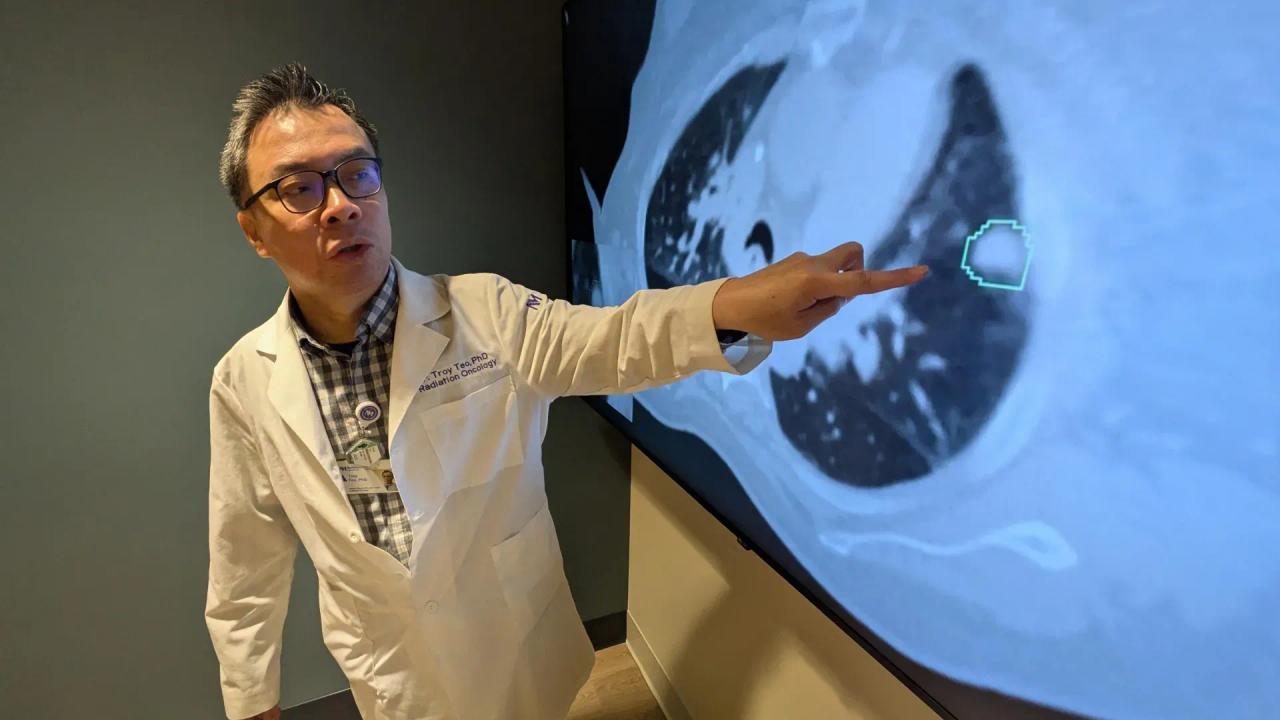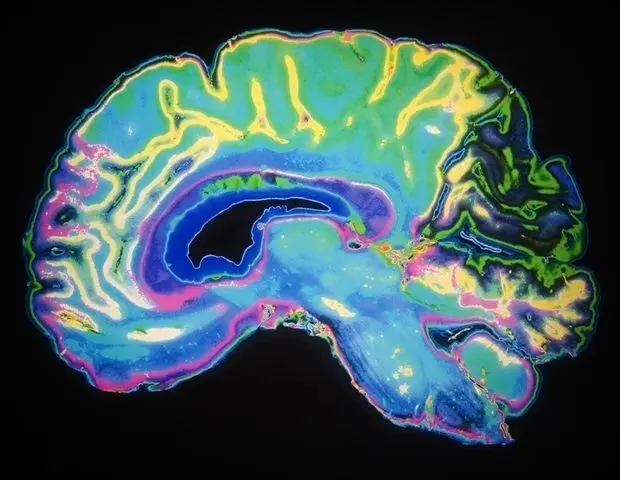AI Tool iSeg Revolutionizes Lung Tumor Mapping for Radiation Therapy
4 Sources
4 Sources
[1]
This AI tracks lung tumors as you breathe -- and it might save lives
In radiation therapy, precision can save lives. Oncologists must carefully map the size and location of a tumor before delivering high-dose radiation to destroy cancer cells while sparing healthy tissue. But this process, called tumor segmentation, is still done manually, takes time, varies between doctors -- and can lead to critical tumor areas being overlooked. Now, a team of Northwestern Medicine scientists has developed an AI tool called iSeg that not only matches doctors in accurately outlining lung tumors on CT scans but can also identify areas that some doctors may miss, reports a large new study. Unlike earlier AI tools that focused on static images, iSeg is the first 3D deep learning tool shown to segment tumors as they move with each breath -- a critical factor in planning radiation treatment, which half of all cancer patients in the U.S. receive during their illness. "We're one step closer to cancer treatments that are even more precise than any of us imagined just a decade ago," said senior author Dr. Mohamed Abazeed, chair and professor of radiation oncology at Northwestern University Feinberg School of Medicine. "The goal of this technology is to give our doctors better tools," added Abazeed, who leads a research team developing data-driven tools to personalize and improve cancer treatment and is a member of the Robert H. Lurie Comprehensive Cancer Center of Northwestern University. The study was published today (June 30) in the journal npj Precision Oncology. How iSeg was built and tested The Northwestern scientists trained iSeg using CT scans and doctor-drawn tumor outlines from hundreds of lung cancer patients treated at nine clinics within the Northwestern Medicine and Cleveland Clinic health systems. That's far beyond the small, single-hospital datasets used in many past studies. After training, the AI was tested on patient scans it hadn't seen before. Its tumor outlines were then compared to those drawn by physicians. The study found that iSeg consistently matched expert outlines across hospitals and scan types. It also flagged additional areas that some doctors missed -- and those missed areas were linked to worse outcomes if left untreated. This suggests iSeg may help catch high-risk regions that often go unnoticed. "Accurate tumor targeting is the foundation of safe and effective radiation therapy, where even small errors in targeting can impact tumor control or cause unnecessary toxicity," Abazeed said. "By automating and standardizing tumor contouring, our AI tool can help reduce delays, ensure fairness across hospitals and potentially identify areas that doctors might miss -- ultimately improving patient care and clinical outcomes," added first author Sagnik Sarkar, a senior research technologist at Feinberg who holds a Master of Science in artificial intelligence from Northwestern. Clinical deployment possible 'within a couple years' The research team is now testing iSeg in clinical settings, comparing its performance to physicians in real time. They are also integrating features like user feedback and working to expand the technology to other tumor types, such as liver, brain and prostate cancers. The team also plans to adapt iSeg to other imaging methods, including MRI and PET scans. "We envision this as a foundational tool that could standardize and enhance how tumors are targeted in radiation oncology, especially in settings where access to subspecialty expertise is limited," said co- author Troy Teo, instructor of radiation oncology at Feinberg. "This technology can help support more consistent care across institutions, and we believe clinical deployment could be possible within a couple of years," Teo added. This study is titled "Deep learning for automated, motion- resolved tumor segmentation in radiotherapy."
[2]
AI tool matches doctors in accurately outlining lung tumors on CT scans
Northwestern UniversityJul 1 2025 In radiation therapy, precision can save lives. Oncologists must carefully map the size and location of a tumor before delivering high-dose radiation to destroy cancer cells while sparing healthy tissue. But this process, called tumor segmentation, is still done manually, takes time, varies between doctors - and can lead to critical tumor areas being overlooked. Now, a team of Northwestern Medicine scientists has developed an AI tool called iSeg that not only matches doctors in accurately outlining lung tumors on CT scans but can also identify areas that some doctors may miss, reports a large new study. Unlike earlier AI tools that focused on static images, iSeg is the first 3D deep learning tool shown to segment tumors as they move with each breath - a critical factor in planning radiation treatment, which half of all cancer patients in the U.S. receive during their illness. We're one step closer to cancer treatments that are even more precise than any of us imagined just a decade ago." Dr. Mohamed Abazeed, senior author, chair and professor of radiation oncology at Northwestern University Feinberg School of Medicine "The goal of this technology is to give our doctors better tools," added Abazeed, who leads a research team developing data-driven tools to personalize and improve cancer treatment and is a member of the Robert H. Lurie Comprehensive Cancer Center of Northwestern University. The study will be published June 30 in the journal npj Precision Oncology. How iSeg was built and tested The Northwestern scientists trained iSeg using CT scans and doctor-drawn tumor outlines from hundreds of lung cancer patients treated at nine clinics within the Northwestern Medicine and Cleveland Clinic health systems. That's far beyond the small, single-hospital datasets used in many past studies. After training, the AI was tested on patient scans it hadn't seen before. Its tumor outlines were then compared to those drawn by physicians. The study found that iSeg consistently matched expert outlines across hospitals and scan types. It also flagged additional areas that some doctors missed - and those missed areas were linked to worse outcomes if left untreated. This suggests iSeg may help catch high-risk regions that often go unnoticed. "Accurate tumor targeting is the foundation of safe and effective radiation therapy, where even small errors in targeting can impact tumor control or cause unnecessary toxicity," Abazeed said. "By automating and standardizing tumor contouring, our AI tool can help reduce delays, ensure fairness across hospitals and potentially identify areas that doctors might miss - ultimately improving patient care and clinical outcomes," added first author Sagnik Sarkar, a senior research technologist at Feinberg who holds a Master of Science in artificial intelligence from Northwestern. Clinical deployment possible 'within a couple years' The research team is now testing iSeg in clinical settings, comparing its performance to physicians in real time. They are also integrating features like user feedback and working to expand the technology to other tumor types, such as liver, brain and prostate cancers. The team also plans to adapt iSeg to other imaging methods, including MRI and PET scans. "We envision this as a foundational tool that could standardize and enhance how tumors are targeted in radiation oncology, especially in settings where access to subspecialty expertise is limited," said co- author Troy Teo, instructor of radiation oncology at Feinberg. "This technology can help support more consistent care across institutions, and we believe clinical deployment could be possible within a couple of years," Teo added. This study is titled "Deep learning for automated, motion- resolved tumor segmentation in radiotherapy." Northwestern University Journal reference: Sarkar, S., et al. (2025). Deep learning for automated, motion-resolved tumor segmentation in radiotherapy. npj Precision Oncology. doi.org/10.1038/s41698-025-00970-1.
[3]
AI matches doctors in mapping lung tumors for radiation therapy
In radiation therapy, precision can save lives. Oncologists must carefully map the size and location of a tumor before delivering high-dose radiation to destroy cancer cells while sparing healthy tissue. But this process, called tumor segmentation, is still done manually, takes time, varies between doctors -- and can lead to critical tumor areas being overlooked. Now, a team of Northwestern Medicine scientists has developed an AI tool called iSeg that not only matches doctors in accurately outlining lung tumors on CT scans but can also identify areas that some doctors may miss, reports a large new study. Unlike earlier AI tools that focused on static images, iSeg is the first 3D deep learning tool shown to segment tumors as they move with each breath -- a critical factor in planning radiation treatment, which half of all cancer patients in the U.S. receive during their illness. "We're one step closer to cancer treatments that are even more precise than any of us imagined just a decade ago," said senior author Dr. Mohamed Abazeed, chair and professor of radiation oncology at Northwestern University Feinberg School of Medicine. "The goal of this technology is to give our doctors better tools," added Abazeed, who leads a research team developing data-driven tools to personalize and improve cancer treatment and is a member of the Robert H. Lurie Comprehensive Cancer Center of Northwestern University. The Northwestern scientists trained iSeg using CT scans and doctor-drawn tumor outlines from hundreds of lung cancer patients treated at nine clinics within the Northwestern Medicine and Cleveland Clinic health systems. That's far beyond the small, single-hospital datasets used in many past studies. After training, the AI was tested on patient scans it hadn't seen before. Its tumor outlines were then compared to those drawn by physicians. The study found that iSeg consistently matched expert outlines across hospitals and scan types. It also flagged additional areas that some doctors missed -- and those missed areas were linked to worse outcomes if left untreated. This suggests iSeg may help catch high-risk regions that often go unnoticed. "Accurate tumor targeting is the foundation of safe and effective radiation therapy, where even small errors in targeting can impact tumor control or cause unnecessary toxicity," Abazeed said. "By automating and standardizing tumor contouring, our AI tool can help reduce delays, ensure fairness across hospitals and potentially identify areas that doctors might miss -- ultimately improving patient care and clinical outcomes," added first author Sagnik Sarkar, a senior research technologist at Feinberg who holds a Master of Science in artificial intelligence from Northwestern. Clinical deployment possible 'within a couple years' The research team is now testing iSeg in clinical settings, comparing its performance to physicians in real time. They are also integrating features like user feedback and working to expand the technology to other tumor types, such as liver, brain and prostate cancers. The team also plans to adapt iSeg to other imaging methods, including MRI and PET scans. "We envision this as a foundational tool that could standardize and enhance how tumors are targeted in radiation oncology, especially in settings where access to subspecialty expertise is limited," said co-author Troy Teo, instructor of radiation oncology at Feinberg. "This technology can help support more consistent care across institutions, and we believe clinical deployment could be possible within a couple of years," Teo added.
[4]
New AI outlines lung tumors better and faster than doctors, study finds
The iSeg system tracks tumors as they move with each breath, offering unprecedented precision for radiation therapy. Scientists have developed a revolutionary new AI tool which, according to a new study, may become crucial in lung cancer screening and treatment. The study, published in the journal npj Precision Oncology, explored the capabilities of a new device, developed by a team at Northwestern Medicine. The device is called iSeg, which comes from its ability to perform tumor segmentation (online or mapping tumors). The traditional process of tumor segmentation is complex and poses challenges for doctors. It can also take multiple doctors visits, several scans, and a great deal of time. In one study, manual segmentation required 12 scans and took doctors seven hours to complete the manual tumor mapping.
Share
Share
Copy Link
Northwestern Medicine scientists develop iSeg, an AI tool that matches doctors in accurately outlining lung tumors on CT scans and can identify areas some doctors may miss, potentially improving cancer treatment precision.
Breakthrough in AI-Assisted Tumor Mapping
Northwestern Medicine scientists have developed a groundbreaking AI tool called iSeg that promises to revolutionize lung tumor mapping for radiation therapy. This innovative technology not only matches doctors in accurately outlining lung tumors on CT scans but can also identify areas that some physicians may overlook
1
.Unique Features of iSeg

Source: Fast Company
Unlike previous AI tools that focused on static images, iSeg is the first 3D deep learning tool capable of segmenting tumors as they move with each breath. This capability is crucial for planning radiation treatment, which approximately half of all cancer patients in the U.S. receive during their illness
2
.Dr. Mohamed Abazeed, senior author and chair of radiation oncology at Northwestern University Feinberg School of Medicine, stated, "We're one step closer to cancer treatments that are even more precise than any of us imagined just a decade ago"
3
.Development and Testing Process
The Northwestern scientists trained iSeg using CT scans and doctor-drawn tumor outlines from hundreds of lung cancer patients treated at nine clinics within the Northwestern Medicine and Cleveland Clinic health systems. This extensive dataset far surpasses the small, single-hospital datasets used in many previous studies
1
.After training, iSeg was tested on patient scans it hadn't encountered before. The study found that the AI consistently matched expert outlines across hospitals and scan types. Importantly, it also flagged additional areas that some doctors missed, with these overlooked areas linked to worse outcomes if left untreated
2
.Related Stories
Potential Impact on Cancer Treatment

Source: ScienceDaily
Sagnik Sarkar, the study's first author and a senior research technologist at Feinberg, emphasized the tool's potential: "By automating and standardizing tumor contouring, our AI tool can help reduce delays, ensure fairness across hospitals, and potentially identify areas that doctors might miss – ultimately improving patient care and clinical outcomes"
3
.Future Developments and Clinical Deployment
The research team is currently testing iSeg in clinical settings, comparing its performance to physicians in real-time. They are also working on integrating user feedback features and expanding the technology to other tumor types, such as liver, brain, and prostate cancers. Additionally, plans are underway to adapt iSeg for use with other imaging methods, including MRI and PET scans
4
.Troy Teo, an instructor of radiation oncology at Feinberg, envisions iSeg as a foundational tool that could standardize and enhance tumor targeting in radiation oncology, especially in settings with limited access to subspecialty expertise. The team believes that clinical deployment could be possible within a couple of years
1
.As the field of AI in healthcare continues to advance, tools like iSeg represent a significant step forward in improving cancer treatment precision and potentially saving lives through more accurate and efficient tumor mapping.
References
Summarized by
Navi
[3]
Related Stories
Recent Highlights
1
X's Paywall Doesn't Stop Grok From Generating Nonconsensual Deepfakes and Explicit Images
Policy and Regulation

2
Nvidia Vera Rubin architecture slashes AI costs by 10x with advanced networking at its core
Technology

3
OpenAI launches ChatGPT Health to connect medical records to AI amid accuracy concerns
Technology








